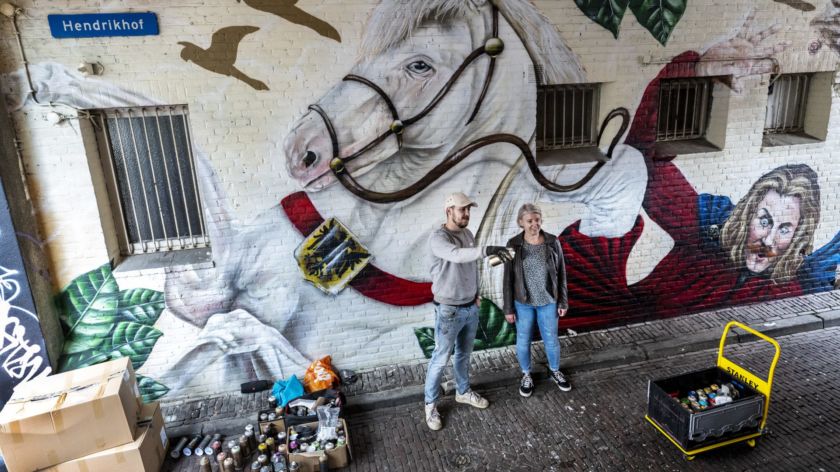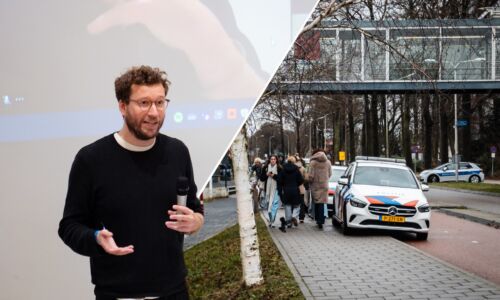King Hendrik, now immortalised in graffiti, gave Nijmegen city rights
-
 Streetartist Sander Dolstra en historica Erika Manders. Foto: Bert Beelen
Streetartist Sander Dolstra en historica Erika Manders. Foto: Bert Beelen
If you go shopping in Nijmegen, you may suddenly find yourself face to face with a king on his deathbed. That is exactly the intention of the series of murals being installed in Nijmegen. The history of the city comes to you. In the Hendrikhof, Hendrik VII was erected this week. ‘He gave Nijmegen city rights in 1230', says historian Erika Manders.
King Hendrik tries to hold on to his horse’s reins. His eyes are filled with fear. Rightly so because the next moment he is dead. The unfortunate fall down a steep mountain path could not be avoided.
This tragic scene was painted this week on the walls of the Hendrikhof, a subway leading to Plein 1944. The painting is part of the series of Waalpaintings, with which the city and university want to bring Nijmegen’s history to life. Or, in this case, trying to depict the death of a ruler.
Electrical box
‘Hendrik VII was a German king who gave Nijmegen city rights in 1230′, says Erika Manders, historian at Radboud University. The idea to immortalise the king falling off his horse came from graffiti artist Sander Dolstra. He was called in to make this Waalpainting. ‘I was given the historical context and a few guidelines’, he says, holding a spray can in his hand. ‘Then I was allowed come up with how I wanted to depict the story.’
Dolstra started work on his artwork in the Hendrikhof last week. First he primed two walls with white paint, then he sprayed reference points on the ‘canvas’. Now he is finishing the scene. For the sake of convenience, he has also painted the air conditioning of clothing store De Tempel, which ends in the alley, in his work of art, just like the electrical box that stands against the wall.
‘This was a disgusting alley’
‘I love history’, says the painter who was born in Nijmegen and now lives in Wijchen. It is his first Waalpainting; the previous murals in the series were made by other artists.
‘We look at each painting to see how we can finance it and which artist we will approach’, explains Erika Manders. ‘This was a disgusting alley, and an additional goal of this project is to beautify the city a little.’
St. Stephen’s Church
All Waalpaintings have their own theme. The Hendrikhof now houses ‘Medieval rulers who played a crucial role in Nijmegen’s city history’. The spot was not picked randomly, as it was already named after the German king. And, what few people will know, Plein 1944 was initially named the King Hendrik square in 1950.
Hendrik VII did not die very heroically, by the way. He got on badly with his father, Emperor Frederick II. At some point the father threw his son in prison in Italy because he would not obey. He gave him a life sentence and when Henry was once again moved from one prison to another, he fell off his horse on a steep mountain path.
On the opposite wall, Sander Dolsma simultaneously depicts Count Otto II of Gelre. This count received Nijmegen as collateral for the 10,000 silver marks he lent to Count William II of Holland, the new king of the German empire from 1247 onwards. From that moment on Nijmegen belonged to the county of Gelre. Otto also initiated the construction of St. Stephen’s Church.
‘Otto II had a club foot’, the artist knows. ‘That is why he was nicknamed horse’s foot. As a wink, I incorporated a piece of a horse in his mural.’
Waalpaintings
The graffiti paintings in the Hendrikhof form the sixth Waalpainting. The project was launched in 2020, with the intention of giving Nijmegen fifteen historical wall paintings. Other themes include the Byzantine princess Theophanu, the Treaties of Nijmegen, and ’the oldest city in the Netherlands’. The project team consists of Erika Manders (Radboud University), Dennis Jussen (De Tijdmachine), Marijn Gielen (Radboud University) and Vincent William (Combolution).



